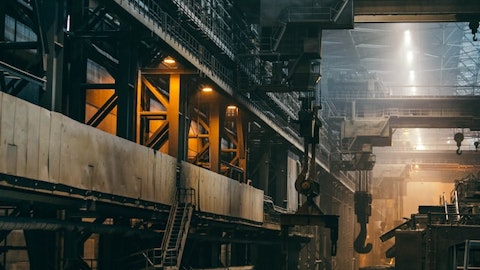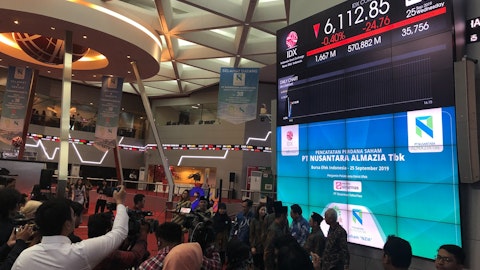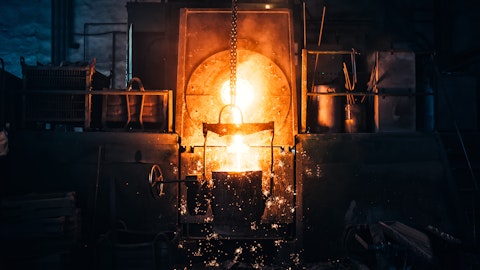Jessica T. Graziano: There’s a little bit of timing. So right now, we’re looking at, let’s call it, maybe $50 million to $100 million of some cash outlay, not commitments, cash outlay that would flow into 2025, but nothing material. The bulk of it — I mean, almost all of it really is going to be completed by 2024.
Alexander Hacking: Okay, thanks. Back to operator [ph].
Jessica T. Graziano: Thanks Alex.
Operator: Thank you very much. We’ll get our next question on the line from Carlos De Alba with Morgan Stanley. Please go right ahead.
Carlos De Alba: Yeah, good morning. Thank you. Just we saw news this morning that you still is increasing [indiscernible] prices or all flat prices by about $100 per ton. Just wanted to maybe — if you could confirm this or what color can you offer, what you see in the marketplace that supports this decision if indeed you’re going ahead with it?
David B. Burritt: I’d say, yes, I confirm that, of course. And obviously, we got a full order book for this quarter. So a lot of the price increases that will come will likely show up in the first quarter of next year. But we’re seeing a lot of different drivers across our four operating segments. And maybe, Kevin, I’ll ask you just to go through each one of these real quickly here to give them a sense of what those drivers are.
Kevin Lewis: Yes. Thanks, Dave. Happy to do that and good morning Carlos. So as Dave mentioned, we were out with a $100 a ton price increase earlier this week. We believe it’s very much supported by the strength that we’re seeing in the order book and the continued momentum that continues to be built here as we conclude calendar year 2024. So you think about automotive, we know it’s been impacted by UAW work stoppage, but hopefully, with some light at the end of the tunnel, we think that will rectify itself in the short term and will continue to support demand through our automotive portfolio. We have a unique and diverse end-market exposure through our product portfolio. So we benefited from increase in inquiries and order activity through line pipe and energy markets.
Appliance sector remains strong, on track to achieve its third best year ever in appliances. Construction has been stable and service center activity, I think from our vantage point, is beginning to increase, and we’re seeing higher levels of order activity in the fourth quarter. So with inventories low and continued strong demand through our diverse end markets, we think the pricing momentum is real and certainly excited about the increase that we announced this week. In Europe, we do expect higher volumes versus the third quarter. We have all three blast furnaces operating for the quarter. We did have a two-month planned outage in Europe. So while demand remains sluggish it is probably how we would call it. We still will be in a position to run all three blast furnaces.
And then Tubular, oil and gas markets are improving. They remain quite strong, and we’ve seen rig counts tick up. Imports have declined throughout — from peak levels, but still remain obviously elevated. And with reduced inventories in the system, we see certainly improved Q4 shipments. So all in all, I think we’re starting to see a positive momentum continue to be built, and we expect that to begin to flow through in Q4 and put us in a very good position to start 2024.
Carlos De Alba: Thank you Kevin. And then just another question. Given that you are well ahead or well advanced in your transformation and with your capital projects on time and on budget, is there any timing as to when would you make a decision on whether to increase the dividend or buybacks and/or establish a capital allocation framework that either links returns to shareholders or money — cash flows to shareholders to EBITDA minus sustaining CAPEX or free cash flow or some sort of that metric?
David B. Burritt: Yes. Carlos, you’ve seen our capital allocation process, if you will, and the priority is for cash, and we’re going to be staying with that. But Jess, maybe you talk a little bit more specifically about the dividend question.
Jessica T. Graziano: Sure. Sure, absolutely. Well, as I mentioned in prepared remarks, I mean, as we continue with the strategic alternatives review process, right, it’s not that we aren’t prioritizing our capital allocation framework. I mean on the contrary, we’ve been checking boxes across those priorities as we manage the business every day. But as far as what’s next, that’s a conversation that if and when appropriate, we would have with our Board. Right now, the focus is on completing a fair and adequate process. The Board is fully committed to and engaged in that process. And as the conversation on capital allocation and priorities with dividend and buybacks will be something we’ll have, again, if and when appropriate. So I appreciate the question.
It’s clear that as we think about where we are in, to your point, the Best for All process, there is a tremendous free cash flow unlock that’s coming for us, as Dave says, as we get to the other side of the mountain on CAPEX. So clearly, we are focused on being the best stewards of that cash, and we’ll have conversations as appropriate on what to do with that cash.
David B. Burritt: We’re focused on very clearly maximizing stockholder value, and the strategic process has put us in a really good place for unleashing a lot of value. And you heard Jess’s remarks about the stock buyback program was delayed, frankly, for confidentiality reasons, because we have lots of information on what’s going on here. So we can’t actually do that program. So we’ve got to get through this, obviously. And you can count on us in this environment. The Board will make a great decision to maximize stockholder value because in fact, every time we meet on this, we talk about our jobs or our fiduciary duties to maximize stockholder value within the code of conduct, our steel principles. So we’re committed to doing that, and then we can talk about some of these other issues. But our priorities are getting through this strategic alternative process and maximizing that value.
Operator: Thank you very much. We’ll proceed with our next question on the line is from Tristan Gresser from Exane BNP Paribas. Please go right ahead.
Tristan Gresser: Yes, hi. Good morning. Thank you for taking my questions. The first one is on Europe. It looks like you operate full again despite the poor market conditions. So if I understood correctly, you don’t anticipate capacity cuts there and maybe shutting down the furnace like last year. And also, you guide for stable EBITDA quarter-on-quarter, but if I look at spot margins there, demand, all the indicators are pretty negative. So why is it not as bad as last year and why your message is a bit more constructive this year versus last year? That’s my first question.
Kevin Lewis: Thanks Tristan, this is Kevin. If we look at the fourth quarter for Europe, you’re right, we’re kind of guiding to a flat quarter-over-quarter level of performance. There are some moving pieces, obviously, that uniquely impact the third quarter, and then we’ll really start to reverse themselves in the fourth quarter, and that’s being some of the significant outage work that was done in 3Q. We do expect to have an order book that supports three blast furnaces worth of production. And we’ll see that really generate sequentially higher shipments in the fourth quarter versus the third quarter. Order of magnitude, maybe somewhere between 30,000 and 40,000 tons quarter-over-quarter of incremental volumes. We are seeing proceeds soften, as you mentioned, in the fourth quarter.



